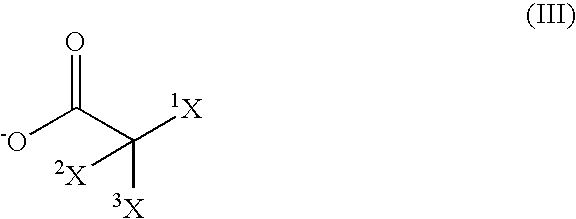Radiation-curing binders and a process for their preparation
a technology of binders and binders, which is applied in the field of radiation-curing binders, can solve the problems of high reaction temperature requirements for this purpose (130° c. ), and achieve the effect of low residual monomer fraction and low viscosity
- Summary
- Abstract
- Description
- Claims
- Application Information
AI Technical Summary
Benefits of technology
Problems solved by technology
Method used
Image
Examples
example 1
Choline 2-ethylhexanoate
[0139] 272.13 g of a 40% solution of choline hydroxide and 145.73 g of 2-ethylhexanoic acid were stirred vigorously for 30 min at RT in a glass flask with reflux condenser, heatable oil bath, mechanical stirrer and internal thermometer. Water and methanol were distilled off in a rotary evaporator at 30-45° C. under a vacuum increased gradually to 20 mbar. The product was then taken up in n-hexane and re-evaporated in the rotary evaporator and dried at 0.1 mbar and 40° C. for 2 h, giving a slightly colored, viscous liquid whose 1H-NMR spectrum showed equi-molar ratios of choline and ethylhexanoate, but only a weak signal in the region of aliphatic carboxylic acids.
example 2
Urethane Acrylate Containing Uretdione Groups
[0140] 194.90 g of Desmodur® N3400, 0.31 g of 2,6-di-tert-butyl-4-methylphenol and 0.005 g of Desmorapid® Z were introduced at RT into a three-necked flask with reflux condenser, stirrer, dropping funnel and air stream (0.5 l / h) and then heated to 60° C. 116.00 g of 2-hydroxyethyl acrylate were slowly added dropwise, during which a maximum temperature of 70° C. was reached. The reaction mixture was then held at 70° C. until the NCO content was <0.1%. On cooling, the product solidified to give a wax-like solid.
example 3
Allophanate-Containing Binder According to the Invention
[0141] In an apparatus analogous to Example 2, 70.2 g of the urethane acrylate obtained therein were melted at 80° C., and 20.0 g of butyl acetate, 9.6 g of an on average tetraethoxylated, trimethylolpropane-initiated polyether (hydroxyl number 550, dynamic viscosity 505 mPa·s at 23° C.) and 0.24 g of the catalyst from Example 1 were added. The reaction mixture was stirred at 80° C. until, after 3.0 h, only a very weak signal for uretdione groups was detected in the IR spectrum at ν=1768 cm−1. The resulting clear product had a viscosity of 5000 mPa·s / 23° C., a solids content of 81.1% and an NCO content of 0%.
PUM
| Property | Measurement | Unit |
|---|---|---|
| Temperature | aaaaa | aaaaa |
| Temperature | aaaaa | aaaaa |
| Molar mass | aaaaa | aaaaa |
Abstract
Description
Claims
Application Information
 Login to View More
Login to View More - R&D
- Intellectual Property
- Life Sciences
- Materials
- Tech Scout
- Unparalleled Data Quality
- Higher Quality Content
- 60% Fewer Hallucinations
Browse by: Latest US Patents, China's latest patents, Technical Efficacy Thesaurus, Application Domain, Technology Topic, Popular Technical Reports.
© 2025 PatSnap. All rights reserved.Legal|Privacy policy|Modern Slavery Act Transparency Statement|Sitemap|About US| Contact US: help@patsnap.com


